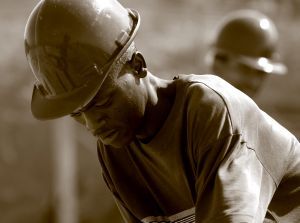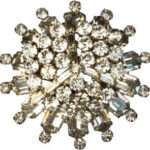In the title sequence of Douglas Sirk’s Imitation of Life, glass diamonds slowly descend from the top to the bottom of the screen, as if being poured into the screen until finally they fill it. Sirk explains this sequence in an interview with the “Cahiers du Cinéma” “stresses the importance he attaches to establishing a distance between the audience and the depicted action” (Willemen, 26.) However this sequence can be read many different ways, for example, the glass, fake, crystals could be read as a foreshadowing of the fake imitations of lives that the characters are living or the crystals filling the screen could be a metaphor for the way that each character tries to collect certain items in order to make themselves feel whole (Annie tries to collects love, Lora tries to collect fame and fortune, ect.) There is really no way to tell what Sirk had in mind since often directors wont tell their true vision for a film.
Race is one of the central themes in the film, and Sirk uses his characters to confuse dominant perceptions of race. Between the four main characters, Lora, Susie, Sarah-Jane, and Annie, the only one that can be pinpointed as black is Annie because of her skin color. This confusion of race that Sirk presents is interesting when compared with anthropometry. In David Green’s article “Classified Subjects” he explains how “the body has remained the visible sign which divides one culture from another” (Green, 37.) However Sirk shows the viewers that “race is… an illusion that does not ideologically work”, because if you cant tell what race someone is, then what makes them that particular race? (Omi/Winant 4.)
The race issues in Sirk’s film are not only explicitly stated through conventions like the doll incident in the beginning or the crawfish scene with Sarah-Jane, they are also shown in the framing. However the framing that is used in these incidents also brings about a feeling that the characters are not genuine, they are phony imitations of what they want to be. One example of this is when Sarah-Jane and Annie are at the apartment where Sarah-Jane is living and we see them both framed in the mirror. Sarah-Jane is in the process of telling her mother that she wants nothing to do with her because she always comes and tells people that she is her mother, which ruins Sarah-Jane’s passing. This is both a moment of extreme racial tension and a moment where the characters are showing how phony they are. Sara-Jane pretends to be white, which she is not, and she will disown her own mother in order to make her own life performing as a white women.
The seedy club where Sarah-Jane first works is interesting when compared with regard to the essay “The Oppositional Gaze: Black Female Spectators” by Bell Hooks. Hooks focuses on the punishment and reprimand that was connected to blacks gazing at whites. Hooks writes “Black men were murdered/lynched for looking at White womanhood,” which is interesting because the bar that Sarah-Jane worked in was designed for black men to go and see white women (Hooks 290.) The bar is designed as a place where black men can “gaze” at white women without reprimand (Hooks, 288.) Hooks explains that the only place where blacks were able to utilize the gaze in spite of their subordinate position is in sites “of resistance for colonized Black people” (Hooks, 289.) The bar itself is like an imitation of real life because in their everyday lives these black men who frequent the bar would not be able to look at white women, but within the walls of the club they are able to physicalize their supposed everyday desires.
Lora Meredith is another character who’s imitation of true life is shown through the framing and through the plot. There is one instance where we see Lora framed in the mirror as she puts on her makeup. The makeup shows that her beauty is not all real and she is in the process of preparing for a show, which is another way that her life is fake. Lora lives through her stage career; she thinks her life is missing something, so she tries to do a serious roll in order to add to her repertoire. However her life is really missing a really genuine relationship, Lora has false relationships with everyone in the film, especially with her daughter. When Susie and Lora are arguing in the bedroom Susie tells her mother that she is always acting, even when she is not on stage. This comment exemplifies Lora’s fake ideas of what life really is, perhaps an imitation of life is all she will ever be able to create because she can only understand life through the stage.
Susie also tells her mother at one point that Annie has been more of a mother to her than Lora has. This further complicates the racial issues in the film because Annie is a better mother to Susie and Sarah-Jane wants to follow in the performer footsteps of Lora. Sirk makes the point that Lora fails as a mother because she works and does not have time for her daughter, but he further complicates that because Annie also fails as a mother and she has plenty or time for Sarah-Jane. It seems that Sirk believes that either too little or too much time can be harmful to a mother daughter relationship and it isn’t necessarily whether or not the mother works, but it is how much quality time she spends with her children and how she loves them that matters.
Lora also has a very strange and phony relationship with Steve Archer. They met on the beach when Lora lost Susie and was frantically looking for her (possibly a foreshadowing to Lora’s later neglect of her daughter.) Annie finds Susie and looks after her until Lora finds them (possibly a foreshadowing of Annie being a better mother to Susie.) Then Steve takes pictures of Sarah-Jane and Susie on the beach, and Steve remains a friend of the family throughout the film. It would appear that Lora has a loving relationship with Steve, however he repeatedly asks her to marry him and give up the stage so that they can be a family and she refuses. The film suggests, as does Steve, that it would be the best thing for everyone, including Susie. However, Lora declines him every time, until the very end of the movie, but even then it is doubtful that she will go through with it. The fact that Lora continually declines Steve’s offer makes their relationship seem unreal. Another factor that leads to this is that their relationship is not cinematically developed, while the relationship between Susie and Steve is. Susie and Steve are shown on multiple outings and some details, like conversations, are given. Lora is lacking a real relationship in her life and she is always wearing mask.
Sarah-Jane really wants to follow in Lora’s footsteps, she practices dancing in her room and the first job that she goes out and gets is performing in a club. However, Sarah-Jane is trying to imitate Lora’s imitation of life. Lora works on Broadway, which seems more legitimately art, while Sarah-Jane works at clubs where “women [are] displayed as sexual objects” and their “erotic… to-be-looked-at-ness” is seemingly the only thing that they have to offer (Mulvey, 62.) No matter how hard Sarah-Jane tries she wont be able to make it to Broadway. Lora has made a name for herself, but it seems that Sarah-Jane will never reach that level of fame and fortune.
The mise-en-scene adds to the over-the-top phoniness throughout the film and the clothing that the four main characters wear is a good indication of their unauthenticness. One example of this is Annie, who perpetually wears black. This seems appropriate if she was a proper maid, but Lora tells her near the end of the film to just relax because they have other people to do the work now. Lora and Susie also have a way of dressing that is over-the-top and phony. Susie wears a pure, white, virginal dress throughout the film. If the dress was only worn once in a symbolic way then it would not seem so phony, but since it is a perpetual symbol throughout the film it seems to be superfluous and it adds to the overall phoniness of the character. Lora is seen throughout the film in gaudy dresses for her plays, however she also wears very stylish dresses in the house. In that beginning of the film Lora’s clothing is made into a point when her new agent wants to take her to a party and lets her wear one of his minks. This shows the emphasis that is put on how people are dressed. Sarah-Jane is another example of an imitation of Lora with regard to her dress. Sarah-Jane wears dresses that resemble Lora’s except that the colors that Sarah-Jane wears are tackier, she wears oranges and turquoise while Lora wears more classic colors like black or white. The costumes reveal that these are only characters, constructed by their creator and that they can never achieve anything more than an imitation of life.
All of the characters in Douglas Sirk’s Imitation of Life are living just that, imitations of what their lives could be. The mise-en-scene and the framing add to this feeling, but even with out these elements the narrative tells it all. Race is complicated by the narrative actions that take place, and Sirk complicates it more with the character Sarah-Jane. She brings up a question that defies the concept of race itself. If no one can tell what race you are, what makes you that race?
Works Cited
Brooks, Peter. Melodramatic Imagination. (New Haven: YaleUniversity Press, 1976.)
Gledhill, Christinr. Home is Where The Heart is. London: British Film Institute, 1987.
Green, David. Classified Subjects. 1984
Hooks, Bell. Black American Cinema. Ed. Manthia Diawara, New York: Routledge, 1993.
Mulvey, Laura. Feminism and Film Theory. Ed. Constance Penley. New York: Routledge, 1988.
Omi, Michael. Winant, Howard. Race, Identity and Representation in Education. Ed. McCarthy, Cameron and Warren Chichlow. New York: Routledge, 1993.
Willemen, Paul. Douglas Sirk. Ed. Laura Mulvey & Jan Halliday. Edomburgh Film Festival, 1976.






